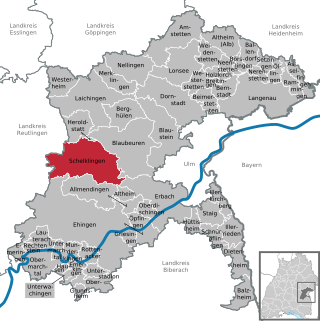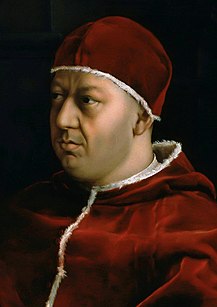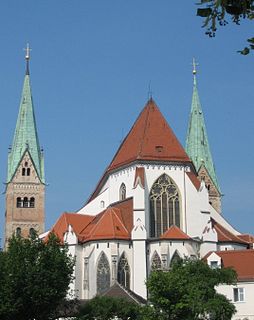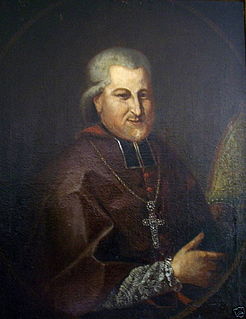Biography

Christoph von Stadion was born in Schelklingen in Mid-March 1478, the son of Nikolaus von Stadion (d. 1507) and his wife Agatha von Gültlingen (d. 1504). [1] In 1490, he began his studies at the University of Tübingen, receiving a bachelor's degree in 1491 and a master's in 1494. [1] He then studied at the University of Freiburg, moving on to the University of Bologna in 1497. [1] Finally, he studied at the University of Ferrara, from which he received a doctorate in law. [1]

Schelklingen is a town in the district of Alb-Donau in Baden-Württemberg in Germany. It is situated 10 km north of Ehingen, and 20 km west of Ulm. Schelklingen with the major part of its territory (82%) forms part of the Swabian Jura Biosphere Reserve.

Gültlingen is a small village in Baden-Württemberg, Germany and is considered a part of the larger Wildberg.

The University of Tübingen, officially the Eberhard Karls University of Tübingen, is a public research university located in the city of Tübingen, Baden-Württemberg, Germany.
He became a canon in the cathedral chapter of Augsburg Cathedral in September 1506. [1] In 1515, he was elected dean of the cathedral chapter. [1] He was ordained as a priest in 1515. [2]

A canon is a member of certain bodies subject to an ecclesiastical rule.
According to both Anglican and Catholic canon law, a cathedral chapter is a college of clerics (chapter) formed to advise a bishop and, in the case of a vacancy of the episcopal see in some countries, to govern the diocese during the vacancy. These chapters are made up of canons and other officers, while in the Church of England chapters now includes a number of lay appointees; in the Roman Catholic Church their creation is the purview of the pope. They can be "numbered", in which case they are provided with a fixed "prebend", or "unnumbered", in which case the bishop indicates the number of canons according to the rents. In some Church of England cathedrals there are two such bodies, the lesser and greater chapters, which have different functions. The smaller body usually consists of the residentiary members and is included in the larger one.

The Cathedral of Augsburg is a Roman Catholic church in Augsburg, Bavaria, Germany, founded in the 11th century in Romanesque style, but with 14th-century Gothic additions. Together with the Basilica of St. Ulrich and Afra, it is one of the city's main attractions. It measures 113 x 40 m, and its towers are 62 m high. It is dedicated to the Visitation of Virgin Mary.
In March 1517, shortly before the death of Heinrich von Lichtenau, Prince-Bishop of Augsburg, the cathedral chapter elected him coadjutor bishop, a selection confirmed by Pope Leo X on April 20, 1517, shortly after the death of Heinrich von Lichtenau. [2] Christoph von Stadion was consecrated as a bishop by Gabriel von Eyb, Bishop of Eichstätt, on July 5, 1517. [2]
Heinrich von Lichtenau (1444–1517) was Prince-Bishop of Augsburg from 1505 to 1517.

A coadjutor bishop is a bishop in the Catholic, Anglican, and (historically) Eastern Orthodox churches whose main role is to assist the diocesan bishop in the administration of the diocese. The coadjutor is a bishop himself, although he is also appointed as vicar general. The coadjutor bishop is, however, given authority beyond that ordinarily given to the vicar general, making him co-head of the diocese in all but ceremonial precedence. In modern times, the coadjutor automatically succeeds the diocesan bishop upon the latter's retirement, removal, or death.

Pope Leo X, born Giovanni di Lorenzo de' Medici, was Pope from 9 March 1513 to his death in 1521.
He held a canonical visitation in the bishopric of Augsburg in 1518 and 1523. [1] In the wake of the papal bull Exsurge Domine (1520), he moved to suppress the Reformation in the bishopric, particularly after 1522. [1] He was unable, however, to halt the spread of Protestant ideas in Augsburg. As a result, he sought to chart a middle course with the Reformers, supporting moderation at the 1530 Diet of Augsburg. [1] He was unable to prevent the expulsion of the Catholic clergy from the city of Augsburg in 1537.
A canonical visitation is the act of an ecclesiastical superior who in the discharge of his office visits persons or places with a view to maintaining faith and discipline, and of correcting abuses. A person delegated to carry out such a visitation is called a visitor. When, in exceptional circumstances, the Holy See delegates an Apostolic visitor "to evaluate an ecclesiastical institute such as a seminary, diocese, or religious institute ... to assist the institute in question to improve the way in which it carries out its function in the life of the Church," this is known as an apostolic visitation.

A papal bull is a type of public decree, letters patent, or charter issued by a pope of the Roman Catholic Church. It is named after the leaden seal (bulla) that was traditionally appended to the end in order to authenticate it.

Exsurge Domine is a papal bull promulgated on 15 June 1520 by Pope Leo X. It was written in response to the teachings of Martin Luther which opposed the views of the Church. It censured forty one propositions extracted from Luther's Ninety-five Theses and subsequent writings, and threatened him with excommunication unless he recanted within a sixty-day period commencing upon the publication of the bull in Saxony and its neighboring regions. Luther refused to recant and responded instead by composing polemical tracts lashing out at the papacy and by publicly burning a copy of the bull on 10 December 1520. As a result, Luther was excommunicated in 1521.
He died in the Monastery of St. Egidien in Nuremberg on April 15, 1543, and was buried in the parish church in Dillingen an der Donau. [2]

St Egidien on Egidienplatz is the former Benedictine Abbey of Saint Giles (Egidienskirche), now a church in the former free imperial city of Nuremberg, southern Germany. It is considered a significant contribution to the baroque church architecture of Middle Franconia.

Nuremberg is the second-largest city of the German federal state of Bavaria after its capital Munich, and its 511,628 (2016) inhabitants make it the 14th largest city in Germany. On the Pegnitz River and the Rhine–Main–Danube Canal, it lies in the Bavarian administrative region of Middle Franconia, and is the largest city and the unofficial capital of Franconia. Nuremberg forms a continuous conurbation with the neighbouring cities of Fürth, Erlangen and Schwabach with a total population of 787,976 (2016), while the larger Nuremberg Metropolitan Region has approximately 3.5 million inhabitants. The city lies about 170 kilometres (110 mi) north of Munich. It is the largest city in the East Franconian dialect area.

Dillingen, or Dillingen an der Donau is a town in Swabia, Bavaria, Germany. It is the administrative center of the district of Dillingen.











